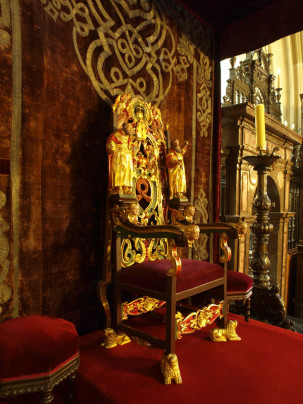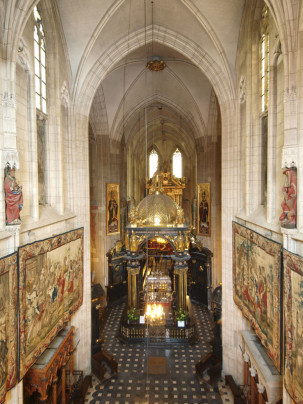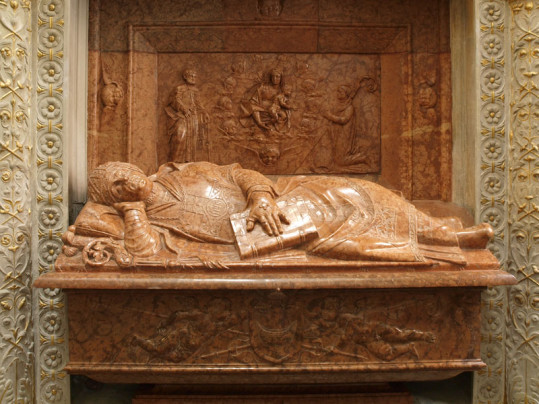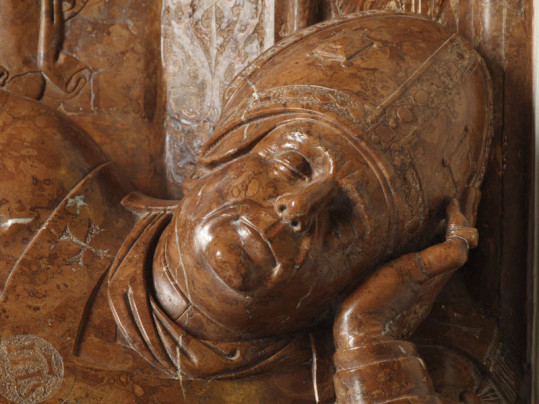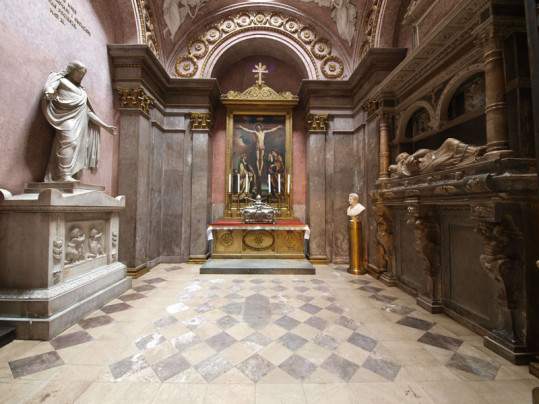Before Cracow became the capital of Poland and the seat of Polish kings, the city had been already been the seat of the Bishopric for nearly 100 years. The cathedral chronology is reflected in the patronage of Wawel Cathedral, whose first patron was St Wenceslaus, a Czech ruler who was murdered in 935. This indicates that church institutions had been present in Cracow earlier than the state institutions.
Thus the identity of the Polish nation was based on the foundation of Christian values which were universal throughout the entire world of the Middle Ages. Wawel Cathedral is the most important church of the Diocese of Cracow, whose host has always been the Bishop of Cracow, currently Cardinal Stanisław Dziwisz. As a rule, ordination ceremonies are held here at each of the three levels: diaconate, presbyterate and episcopate. The Bishop of Cracow celebrates solemn ceremonies at the cathedral on the most important state or church holidays.
The throne of Cracow bishops is on the right side of the High Altar to remind the faithful of the bishop’s constant symbolic presence of in the cathedral. Throughout the centuries, the Bishops of Cracow were the second most important representatives of the Church in the spiritual and political life of Poland, after the Archbishops of Gniezno. They ruled one of the country’s wealthiest and largest dioceses. When the Cracow Academy was founded, the Bishops of Cracow were its Chancellors. Beside their religious and social activity as diocese ordinaries, they were also often senators or ministers and influenced the course of political, economic and cultural events in Poland. Bishops’ sarcophaguses at Wawel Cathedral evidence the continuity of the Cracow Diocese.
- The throne of the Bishops of Cracow
- The Altar – confession of St Stanislaus
The central place in the Cathedral is occupied by the confession of the most important figure among Cracow bishops – St Stanislaus, bishop and martyr, the patron saint of Wawel Cathedral and of the Polish State. Following the canonisation of Bishop Stanislaus, which took place in Assisi in 1253, the relics of the saint were placed in a silver-coated wooden coffin founded by Blessed Kinga and buried in the central place of the Romanesque cathedral. The present confession is in the form of a domed canopy in black and rose marble, gilt bronze and wood, and was created in the years 1626-1629 on Bishop Marcin Szyszkowski’s foundation. The canopy shelters the reliquary in the form of a silver coffin, executed in Gdańsk in the years 1669-1671.
The first bishops’ graves were destroyed in the course of the construction of the Gothic cathedral in the 14th century. The earliest grave still existing is the burial place of Bishop Maurus (died 1118). The objects from his grave are displayed in the Cathedral Museum at Wawel.
- The effigy of Bishop Tomicki
In the central part of the Wawel Cathedral’s chancel one of the most prominent politicians of the times of Wladysław Jagiełło and Władysław of Varna – Cardinal Zbigniew Oleśnicki – is buried (died 1455). His monument, executed in 1900 at the Vienna workshop of Kasper Klemens Zumbusch, is in the north wing of the ambulatory.
Cardinal Ferdynand Jagiellon, a son of King Kazimierz Jagiellon, is buried in the chancel. He was the highest church dignitary in Poland in his times, as he was both Archbishop of Gniezno and the Bishop of Cracow. His sarcophagus was founded in 1510 by his brother, Zygmunt (Sigismund) I the Old, and is one of the most splendid works by the famous foundry workshop of Peter Fischer of Nuremberg. The Gothic-Renaissance bronze plate which marks the burial place of the cardinal may be seen between the stairs leading to the high altar.
Renaissance monuments of bishops, among which is the sarcophagus of Bishop Jan Konarski, executed at the workshop of the Italian architect and sculptor, Bartlomeo Berrecci, have an important role in the cathedral. The sarcophagus is in the Chapel of the Immaculate Conception of the Holy Virgin Mary, which in the years 1520-1521 was adapted as a mausoleum of Bishop Jan Konarski.
Another work by Bartolomeo Berrecci is the sepulchral chapel of Bishop Piotr Tomicki, a representative of the Polish political and intellectual elite of the Renaissance era. This was the first domed chapel in Poland, next to the Sigismund Chapel. Of its once rich furnishings, only the splendid sarcophagus of its founder has survived, along with some details of the altar, a painting depicting the Adoration of the Three Kings, and a bas-relief featuring God the Father and the Holy Ghost in the form of a dove.
The sarcophagus of Piotr Gamrat, the Archbishop of Gniezno and the Bishop of Cracow, is the work by Giovanni Maria Padovano. It may be seen at St Catherine’s Chapel which, in the years 1545-1547, was remodelled to serve as the bishop’s mausoleum on the order of Queen Bona.
Sepulchral chapels of bishops Andrzej Zebrzydowski and Filip Padniewski were noteworthy for their original, Mannerist decor. Both chapels were designed and executed by Jan Michałowicz of Urzędów. Unfortunately only sepulchral monuments have survived to this day, as the chapels were thoroughly remodelled in later times. The Padniewski Chapel has been partially reconstructed, so its cupola with highly impressive tambour decorations may be seen from the outside. The ornaments are in the form of alternating semi-columns and volutes, which gives the impression of movement.
The most popular sarcophaguses in the 17th century were in the form of busts of the deceased persons, in a style taking its origins from Rome. Four Baroque statues of the bishops of Cracow Marcin Szyszkowski (died 1630), Piotr Gembicki (died 1657), Jan Małachowski (died 1699) and Kazimierz Łubieński (died 1719), were placed around St Stanislaus’ confession standing over the crypt in which the bishops are buried. The bust of Bishop Gembicki, executed to the Roman sculptor Giovanni Battista Gisleni’s design, is particularly noteworthy for its artistry. A similar sarcophagus in the lavish early-Baroque sepulchral chapel of St John the Baptist commemorates bishop Jakub Zadzik.
- The effigy of Archbishop Gamrat (detail)
- Bishop Padniewski’s Chapel
In the 18th century the splendid monuments with portraits in medallions, symbolic sarcophaguses, obelisks and allegories, all to glorify the deceased person and remind of the ultimate matters, became popular. In this way Cardinal Jan Aleksander Lipski was honoured, whose sarcophagus is in the form of an elaborate catafalque in black marble and alabaster. It can be seen in the splendid late-Baroque Chapel of SS Matthias and Matthew, reconstructed by the architect Francesco Placidi.
The latter also rebuilt the mediaeval Crypt of St John the Evangelist for the mausoleum of one of the illustrious Polish dignitaries in the times of the Saxon dynasty – Bishop Andrzej Stanisław Kostka Załuski, whose monumental effigy fills the niche above the portal. The late-Baroque monument of Bishop Jan Grot can also be seen in this chapel.
The political situation and the lack of funding in the 19th century did not create favourable conditions for the commissioning of new bishop monuments, so, with the exception of modest epitaphs and sepulchral plates, only one such monument was created – that of the restorer of the Cracow Bishopric, Cardinal Albin Dunajewski. One of the last bishops to have been buried in the cathedral was Cardinal Adam Stefan Sapieha. His bronze bust can be seen on the left side of the High Altar.
A special place in the Pantheon of Cracow bishops is due to Cardinal Karol Wojtyła, who was raised to the highest Church dignity and became the spiritual father of the entire world as Pope John Paul II. In 2008 his monument was built, facing the entrance to Wawel Cathedral.

